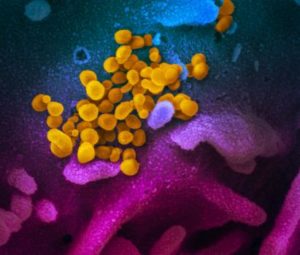 If you're a hunter or eat wild-caught game (deer, elk, moose, reindeer), then you should be concerned with chronic wasting disease (CWD). Chronic wasting disease is an always-fatal prion disease similar to "mad-cow disease" (bovine spongiform encephalopathy) in cattle.
If you're a hunter or eat wild-caught game (deer, elk, moose, reindeer), then you should be concerned with chronic wasting disease (CWD). Chronic wasting disease is an always-fatal prion disease similar to "mad-cow disease" (bovine spongiform encephalopathy) in cattle.
In chronic wasting disease there is a long incubation period, followed by the brain become progressively like a sponge - riddled with holes, along with deterioration in brain function, behavioral changes, and eventually death. A horrible slow death. There are no treatments or vaccines.
It turns out that chronic wasting disease is slowly spreading and infecting wild game across the United States (26 states) and 3 Canadian provinces. [Also detected in Finland, Norway, South Korea, and Sweden.] The concern is that this disease will jump to humans, especially in people who eat contaminated meat.
A research center monitoring the situation and publishing information and research on its site is CIDRAP (Center for Infectious Disease and Policy). Make sure to look at the Tweets (Twitter).
One scary thing about CWD is that once it gets into the soil, it stays there for years, and high heat, disinfectants, and radiation don't kill it. Yikes! Dr.Zabel at the Colorado State Univ. Prion Research Center suggested a few years ago that controlled burns (fires) of infected fields or areas could eliminate the prions left behind by infected animals (from animal mucus/saliva, urine, and feces, and decaying carcasses) on plants and soil.
An article with advice for how hunters can protect themselves, and a map of where CWD is found in the US.: 5 Ways Hunters Can Prevent Spreading Chronic Wasting Disease
The Centers for Disease Control and Prevention (CDC) has several chronic wasting disease pages, including prevention and transmission.
Here is some of what CIDRAP says on their site about CWD:
Chronic wasting disease (CWD) is a prion disease that affects several cervid species: deer, elk, reindeer, sika deer, and moose. CWD was first identified in 1967 in a captive mule deer living in a Colorado research facility. In 1981, CWD was detected for the first time in a wild cervid. Since these initial detections, CWD has been identified in 26 states and three Canadian provinces. It has also been detected in Finland, Norway, South Korea, and Sweden. ...continue reading "Chronic Wasting Disease Is Spreading In the United States"

 It turns out that people experiencing a major depression have differences in their gut microbiome (community of microbes) when compared to healthy people who are not depressed. A persistent and prolonged period of extreme sadness or depression is called a major depressive disorder (MDD).
It turns out that people experiencing a major depression have differences in their gut microbiome (community of microbes) when compared to healthy people who are not depressed. A persistent and prolonged period of extreme sadness or depression is called a major depressive disorder (MDD). It is shocking that the same virus can result in the majority of people with COVID-19 having minimal or no symptoms, but others really suffering or even dying from it. We now know that after developing a COVID-19 infection, some people seem to be ill with symptoms for weeks and even months. This has been referred to as "long-COVID" or "long-haul COVID".
It is shocking that the same virus can result in the majority of people with COVID-19 having minimal or no symptoms, but others really suffering or even dying from it. We now know that after developing a COVID-19 infection, some people seem to be ill with symptoms for weeks and even months. This has been referred to as "long-COVID" or "long-haul COVID".
 It's hard to believe in this month of cold and snow, but climate scientists are saying that 2020 is almost tied with 2016 to be the hottest year on record. This past decade has been the hottest ever recorded, and the last
It's hard to believe in this month of cold and snow, but climate scientists are saying that 2020 is almost tied with 2016 to be the hottest year on record. This past decade has been the hottest ever recorded, and the last 
 Many people have noticed that marijuana (cannabis) has gotten stronger over the past decades, and now a study agrees. The THC in marijuana is what gives a person a "high", and those levels have really increased since 1970. That means what was smoked at Woodstock back in1969 was much milder than what is being smoked today.
Many people have noticed that marijuana (cannabis) has gotten stronger over the past decades, and now a study agrees. The THC in marijuana is what gives a person a "high", and those levels have really increased since 1970. That means what was smoked at Woodstock back in1969 was much milder than what is being smoked today. Frequently seen during November.
Frequently seen during November.
 If you're a hunter or eat wild-caught game (deer, elk, moose, reindeer), then you should be concerned with chronic wasting disease (CWD). Chronic wasting disease is an always-fatal prion disease similar to "mad-cow disease" (bovine spongiform encephalopathy) in cattle.
If you're a hunter or eat wild-caught game (deer, elk, moose, reindeer), then you should be concerned with chronic wasting disease (CWD). Chronic wasting disease is an always-fatal prion disease similar to "mad-cow disease" (bovine spongiform encephalopathy) in cattle. Another health benefit of coffee! A study found that daily consumption of a few cups of coffee was associated with longer survival and a lower risk of cancer worsening in persons with metastatic colon cancer. These benefits held for both caffeinated and decaffeinated coffee. This is a big deal because metastatic colon (colorectal) cancer only has a 5 year survival rate of 14%.
Another health benefit of coffee! A study found that daily consumption of a few cups of coffee was associated with longer survival and a lower risk of cancer worsening in persons with metastatic colon cancer. These benefits held for both caffeinated and decaffeinated coffee. This is a big deal because metastatic colon (colorectal) cancer only has a 5 year survival rate of 14%. Word wildlife numbers are catastrophically plummeting - an average of 68% decline in almost 21,000 wildlife populations between 1970 and 2016 (46 years). Two thirds of all wildlife! This is the conclusion of the
Word wildlife numbers are catastrophically plummeting - an average of 68% decline in almost 21,000 wildlife populations between 1970 and 2016 (46 years). Two thirds of all wildlife! This is the conclusion of the